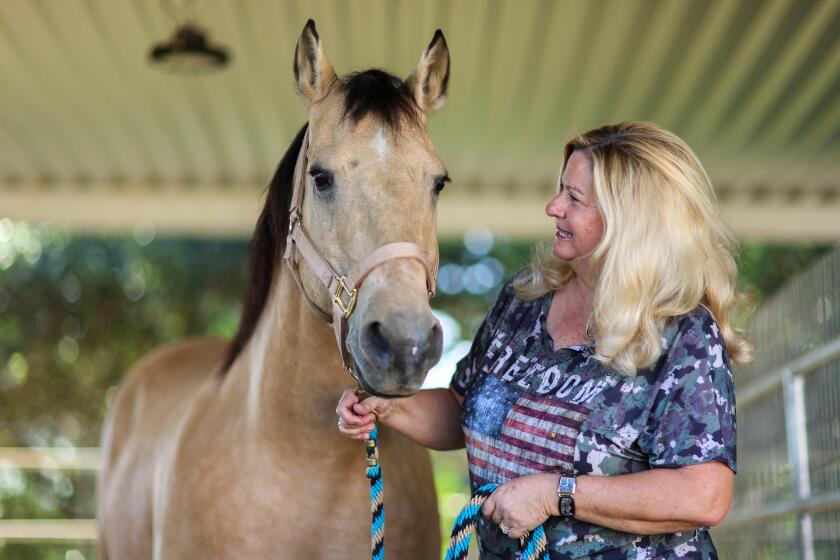A landslide destroyed O.C. homes 24 years ago. A developer wants to build there again
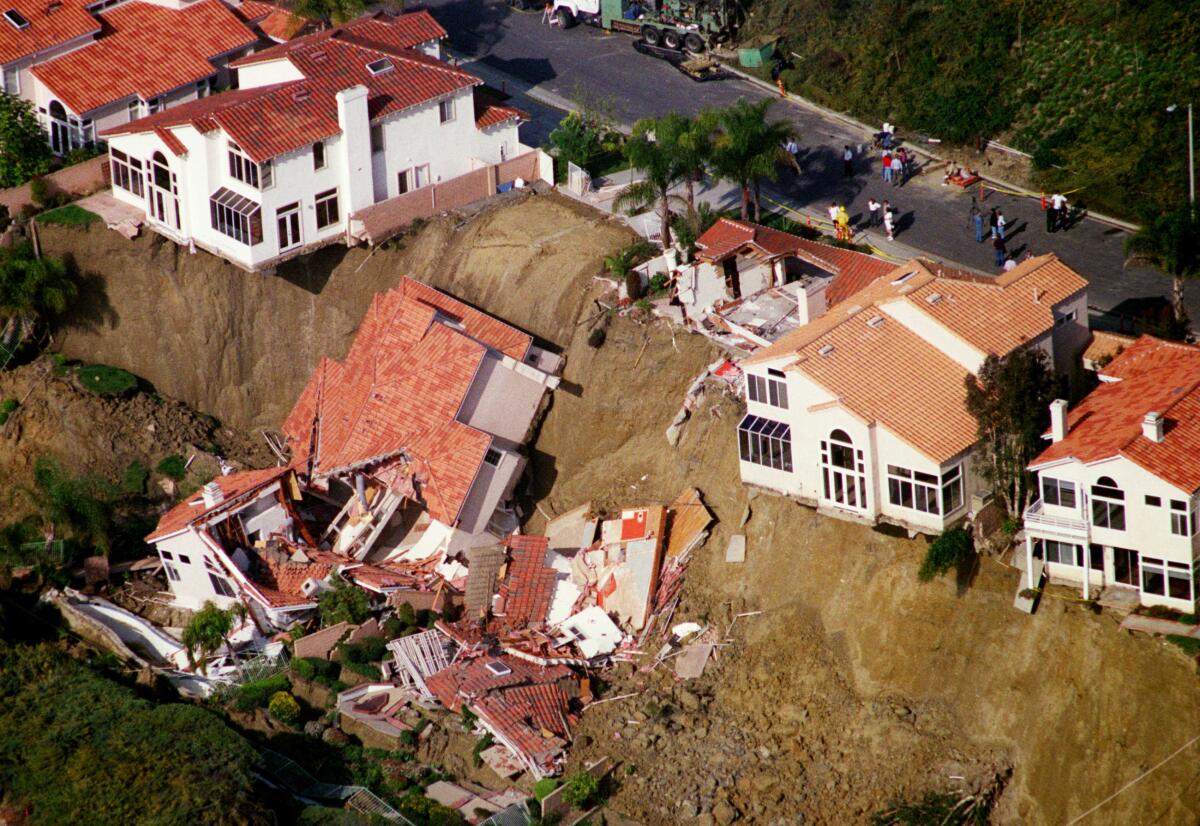
- Share via
In 1998, after a winter of heavy rains, the hill below Via Estoril collapsed.
Several homes slid down, others were destroyed, and the condominiums below were heavily damaged.
Residents of the Laguna Niguel neighborhood, where ridgetop homes have swimming pools and panoramic views, were sure that no one would ever think of building there again.
Now, 24 years later, a developer is proposing new condominiums at the base of the hill. Improvements made since the landslide will prevent disaster from striking again, the project’s proponents say.
The developer, Barry Hon of Laguna Niguel Properties LLC, is familiar with the risk. He built the original Niguel Summit neighborhood, including the Via Estoril homes, which now sell for more than $1 million, and the condos below.
Residents fear that Hon’s new project will destabilize the hill and send it crashing down again.
“We just don’t want to have to live with that kind of fear and uncertainty and have people move in below us who might also be in danger,” said Sara Nuss-Galles, who has lived on Via Estoril since 2005.
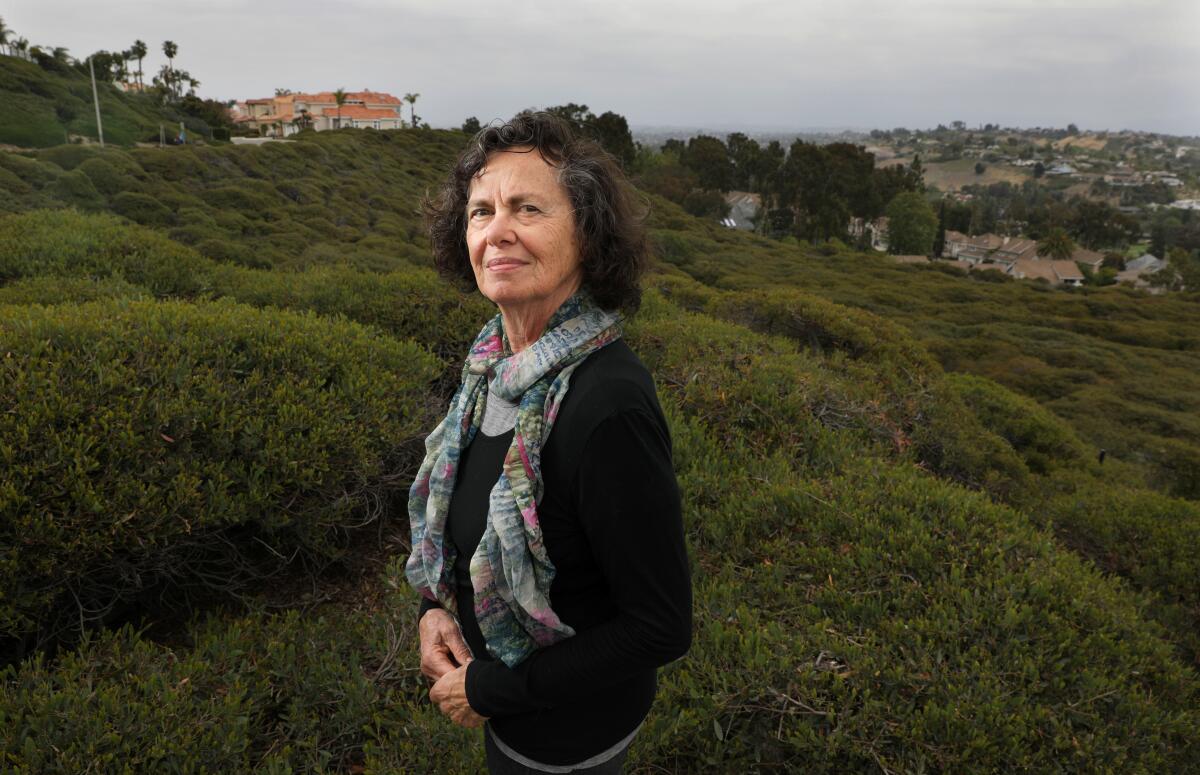
Many also worry that officials will use the increasing demand for housing across Southern California and a requirement that the city zone for more than 1,200 new units as justification to approve the project, when there are safer places in the city to build.
“It is hard to stop development in California,” said Jim Kozel, who lives in Niguel Summit. “It’s our understanding that fighting this is going to be difficult, but we have to protect the homeowners.”
“Who wants to live in a congested urban environment?” said Newport Beach Councilwoman Diane Dixon.
In the 1980s, Hon built about 1,500 homes, including the ones on Via Estoril, on a man-made hill about five miles from the ocean.
Years later, residents on Via Estoril began complaining about cracking walls and sagging fences. At the 41-unit condominium complex below, residents also saw cracks in their walls, and the sidewalks buckled as the earth shifted underneath. Some sued the developer, alleging faulty construction.
Carolyn Brown and her husband, Fred Brown, bought a home on Via Estoril in 1995, drawn to the cool ocean breeze and the view of the Pacific.
A year and a half later, they noticed cracks widening in their driveway and along a retaining wall. Officials determined that the slope was shifting more rapidly after El Niño storms in late 1997.
Officials soon red-tagged several homes on Via Estoril. The structures creaked and glass popped as residents rushed to pack their belongings.
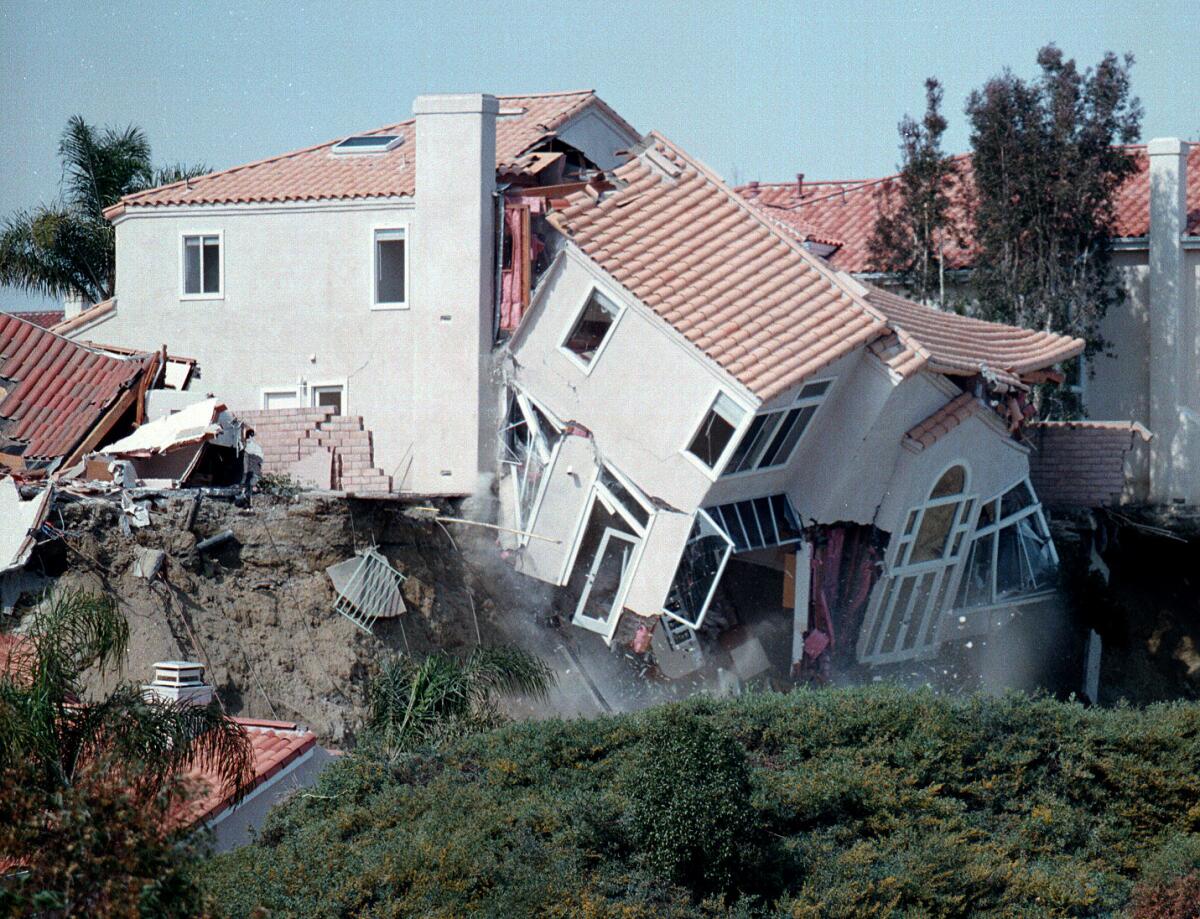
“I remember walking into our bedroom, which was on the back side of the house, and there was this built-in cabinet with drawers, and all the drawers were open,” Carolyn Brown recalled recently. “I looked in the corner of the bedroom. There was a huge gap, and I realized, ‘Oh my God, the house is tilting, and that’s why these drawers have opened up.’ I immediately got out of there and never went back.”
When the hill finally gave way, it sounded like thunder. Two large two-story homes slid down and crumpled into heaps.
The Browns’ home dangled above the hillside for days before disintegrating. In all, nine homes on the ridge were destroyed.
Below, several condominium units were also destroyed, and the entire complex was demolished so the land could be graded to stabilize the area.
The developer and original builder, J.M. Peters, paid millions to the Niguel Summit Community Association as part of a legal settlement. The money was used to build a massive concrete wall with tieback anchors, a giant mass of soil called a buttress, and subdrains to move rainwater.
City officials told residents it was highly unlikely that the land would be built on again.
But the area remained zoned for homes. The city was set to receive a $5.6-million grant to purchase the land and designate it open space, until the Federal Emergency Management Agency pulled back the funding because homeowners had already been paid legal settlements.
Hon and his company are proposing 22 three-story condos on less than two acres at the bottom of the hill along Crown Valley Parkway.
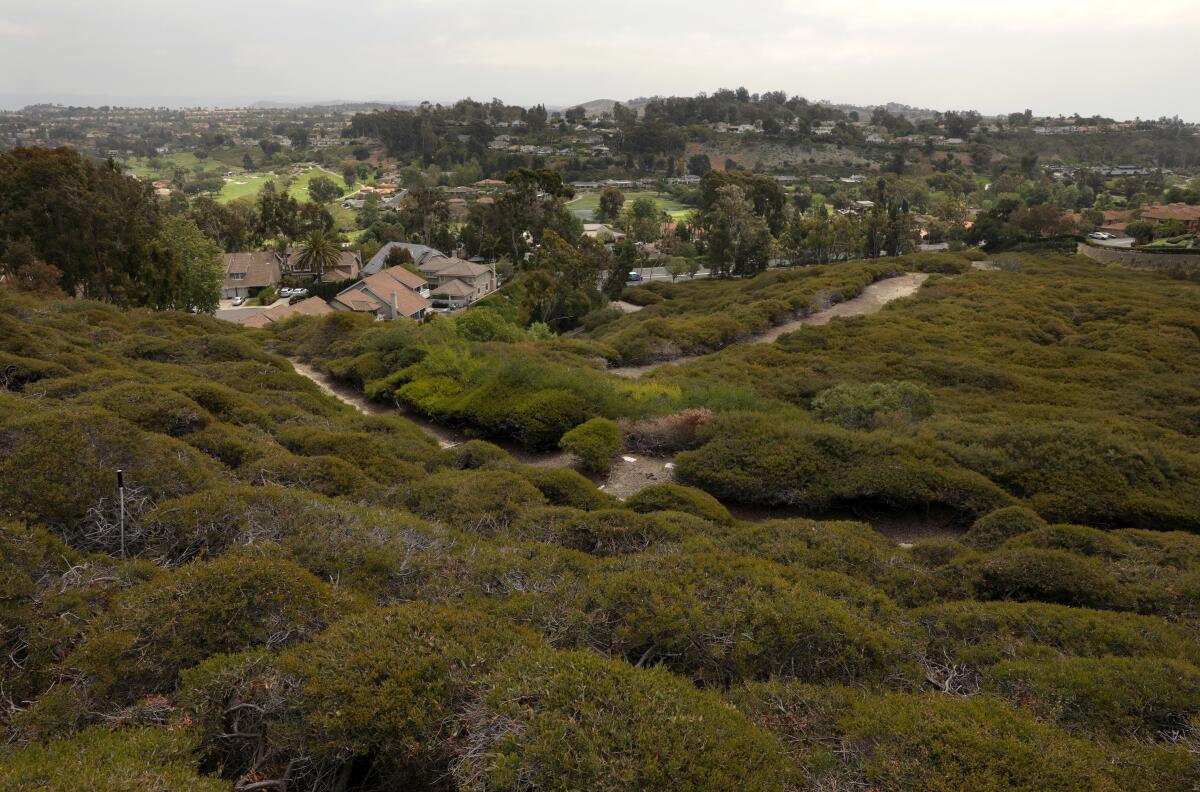
The units are designed to appeal to young people, with floor plans to accommodate working from home and oversized garages that can be used for exercise equipment. Similarly-sized condominiums elsewhere in the city have recently sold for more than $600,000.
“With the city of Laguna Niguel on the edge of a generational shift, the proposed 22 townhomes are responsive to that and seek to attract a younger demographic to the city,” said Marice DePasquale, the community outreach liaison for the project.
DePasquale said the condos, called “The Cove at El Niguel,” will not be built on the landslide footprint and that neighbors’ views will not be affected.
The landslide area “has been stabilized and is suitable to accommodate the plan as currently proposed,” she said.
To provide space for yards and a retaining wall, the construction plan would involve grading the bottom edge of the soil buttress that helps stabilize the hill.
According to geotechnical experts hired by the developer, as well as a separate firm that reviewed the plans for the city, shaving off part of the buttress is safe and won’t affect the stability of the hillside.
The developer has prepared a draft environmental impact report, and the proposal will eventually come before the Laguna Niguel Planning Commission for approval.
It does not need to be approved by the City Council.
Planning Commission Chair Brian Fisk said the proposed condos will take up much less land than the ones that were demolished. He noted that the proposal does not involve building on the hillside.
“We have to rely on our professional consultants that work with the city to address those concerns and then our professional planning staff and the legal team that completes an environmental impact report,” Fisk said. “If we cannot rely on that, then I don’t know what we can rely on.”
Laguna Niguel, like much of Orange County, typically fields proposals for apartments or single family homes. Condominiums are less common, Fisk said.
“We’re looking at whether it’s suitable to have residential there again,” said Fisk, a retired city planner. “This meets the objectives of creating additional housing opportunities in the city, and it’s a for-sale product that we don’t have a lot of.”
As home prices soar amid a longstanding housing shortage, well-heeled suburbs like Laguna Niguel that have room to grow are facing increasing pressure to build.
A state law requires local governments to prepare a plan for new housing every eight years. Cities are assigned a specific number of new units under a complex formula that anticipates future housing needs.
Laguna Niguel’s requirement, approved by the city last year, is to zone for 1,207 new housing units.
Don Ware, who lives up the hill in Niguel Summit and worked for decades as a petroleum geologist, is skeptical that building below the buttress is safe. Even now, he said, the soil has slowly been creeping and settling toward the bottom of the hill.
The proposal includes a wall that would hold back the soil but isn’t intended to stabilize a landslide zone, Ware said.
“I don’t think it’s a good idea to put houses down below a landslide that was repaired with the understanding that there wouldn’t be any houses built there,” Ware said. “So the question for me is always: ‘Well, would you have repaired this slide differently if you knew you were going to do a development down below?’ I haven’t gotten a clear answer.”
Many south and coastal Orange County cities, including Laguna Niguel, have a long history of landslides.
In Laguna Beach, a 1978 landslide destroyed more than 20 homes in Bluebird Canyon. The same area slid again in 2005, destroying 17 homes.

Niguel Summit was built on at least six old landslide areas that were graded and buttressed.
A geological consultant told the developer that stability levels were “generally less than acceptable,” The Times reported in 1998, and that large parts of the parcel were “probably unstable.”
Rebuilding in landslide areas isn’t uncommon but must be done carefully to ensure the land remains stable, said Serge Tomassian, an Irvine attorney who has represented property owners following landslides.
Homebuyers should research landslide risk, but they are often caught unaware, Tomassian said.
Tomassian said cutting into a buttress is risky, and he would be surprised if the city approves such a plan.
Many nearby residents are worried that city officials may put the need for housing above safety concerns.

Nathan Smith bought a house in the Charter Terrace neighborhood, next to the proposed condo development, in 2013. He was attracted to the backyard view of the buttress, which looks more like a lush hillside than a strategy to keep landslides at bay.
Later, it became the first home he shared with his wife and the place where they are raising their two children.
But he is thinking about moving if the condos are approved.
It’s not that he or his neighbors are anti-development, he explained as he looked out over the hillside, still green despite the season’s lackluster rains, in early May.
It’s the fear that what happened 24 years ago could happen again.
“If this was a flat parcel with no tortured history,” he said, “it would be a different story.”
More to Read
Sign up for Essential California
The most important California stories and recommendations in your inbox every morning.
You may occasionally receive promotional content from the Los Angeles Times.
